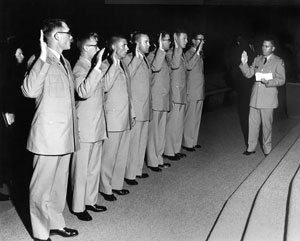| Goolsby grads on the fast track | Help for the struggling | Recognition of contributors |
| Home Forethought President's Message Campus Buzz Feature Stories Re:Search The Score Alum News Yesteryear | ||
The commissioning of the University's 1,000th cadet in December (see p. 4) brought back special memories for alumnus Charles Feuerbacher. On May 30, 1961, he was the first.
|
|
Seven cadets composed the inaugural group at what was then Arlington State College. ASC also celebrated its first bachelor's degree commencement exercises that day after making the transition from a junior college to a four-year institution in 1959.
The seven—Feuerbacher, Buck Herndon, Roger Kannady, Glynn Osburn, Bill Pinkerton, Zack Prince and Rob Roten—attended ceremonies at the First Baptist Church in Arlington.
"At the time it was the only place in town large enough to accommodate the expected crowd," Herndon explained.
ASC President Jack Woolf presided over the commencement ceremonies, and Lt. Col. John Chambers, professor of military science and tactics, presented the officer candidates after the graduation exercises. Maj. Gen. J. Earl Rudder, president of Texas A&M University, did the actual commissioning.
"Since this was the first graduation for Arlington State as a four-year college, everything was special," Feuerbacher said. "Once we got our commissions, we had our new gold bars pinned on our uniforms. One of my bars was pinned by my mom, who lived in Dallas, and the other was put on by Priscilla Cooper, from Arlington, whom I married on October 21, 1961."
As tradition goes, when the cadets stepped off the stage and received their first salute from a noncommissioned officer, they were expected to give a dollar to the NCO who gave them that first salute.
| The cadets: Where are they now? Charles Feuerbacher. Retired colonel. His military retirement in 1987 was followed by a career in banking, primarily in the corporate trust department. Member of the UT Arlington Military Science Hall of Honor. Lives in Austin. William “Buck” Herndon. Retired lieutenant colonel. Retired from the Army Reserve in 1989 and from the Texas Department of Transportation in 1998. Member of the UT Arlington Military Science Hall of Honor. Lives in Fort Worth. Roger Kannady. Sold his sales agency in the heating, ventilating and air conditioning business in 1998. Now the manager of new product development for Recorseal Corp. in Houston, where he lives. Glynn Osburn. Retired lieutenant colonel. Served in the Defense Intelligence Agency for 5½ years. Operated small businesses until 1993 when he became a teacher in the Arlington Independent School District. Lives in Bedford. Bill Pinkerton. Retired major. Taught military science at Rice University. Now chief counselor for a medical prison in Georgia. Lives in Augusta, Ga. Zack Prince. Retired captain. Became assistant registrar at UT Arlington in 1964 and registrar in 1970. Retired from UT Arlington in 2002. Member of the UT Arlington Military Science Hall of Honor. Lives in Arlington. Rob Roten. Retired as manager of technical services after working 34 years with Campbell Soup Co., including stints in South Carolina and Arkansas. Lives in Paris, Texas. |
"You can imagine that there was a line of NCOs waiting to get their dollar," Feuerbacher said. "In my case, I had gotten a bright silver dollar to pay for my first salute. As I remember, it went to Master Sgt. J.W. Morris, who was our rifle team coach. I had spent many hours with him practicing for and competing in rifle competitions."
The ROTC program had more than 500 cadets at the time. Prince remembers the entire corps marching in formation to the drill field on the west side of Cooper Street each Thursday afternoon. Many cadets lived in Davis Dorm (now Brazos Hall). The students were predominantly commuters, including veterans taking advantage of GI Bill benefits earned during the Korean conflict.
"Some students drove in from the Dallas and Fort Worth areas, went to class and then left to go home or to work," Feuerbacher said. "The ladies had social clubs instead of sororities. In lieu of fraternities, we had clubs and ROTC. Who needed anything else?"
Pinkerton recalls getting pranked.
"The guys and gals got the better of me when they kept a big secret and got me voted in as an ASC cheerleader," he said. "This was completely out of character for me, but I did my best. I would lead cheers and then march with the Jodies drill team at halftime. There were some humorous happenings during my tenure as a cheerleader. I actually enjoyed it after a while."
The early '60s was a time of uncertainty, especially for someone entering the military. John F. Kennedy took office as president in January 1961, and the Bay of Pigs invasion occurred that spring. Other monumental events soon followed: the building of the Berlin Wall, the John Glenn space flight, the Cuban missile crisis, JFK's assassination.
"Most of the cadets had a strong camaraderie," Prince said. "The cadre was excellent about training us and instilling a sense of honor and pride about gaining a commission in the U.S. Army."
One thousand cadets later, the same holds true.
— Jim Patterson
| Archives
| Alumni Association |
Giving to UT Arlington | UT
Arlington Home Copyright © 2007 UT Arlington Magazine. All rights reserved. |

